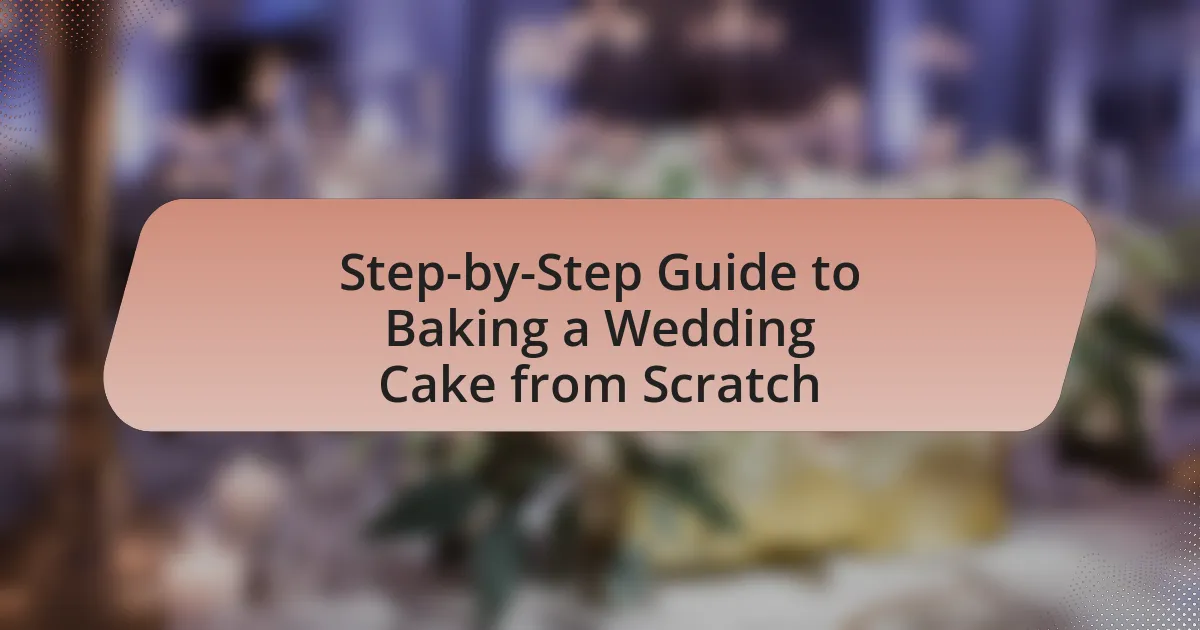A wedding cake is a multi-tiered cake traditionally served at wedding receptions, symbolizing prosperity and good fortune for the couple. This article provides a comprehensive guide to baking a wedding cake from scratch, detailing essential steps, ingredients, and techniques to achieve a light and fluffy texture. It covers the significance of wedding cakes, common types and flavors, as well as decoration methods that reflect personal tastes and wedding themes. Additionally, the article addresses best practices for measuring ingredients, troubleshooting baking issues, and ensuring proper storage and transportation of the cake.
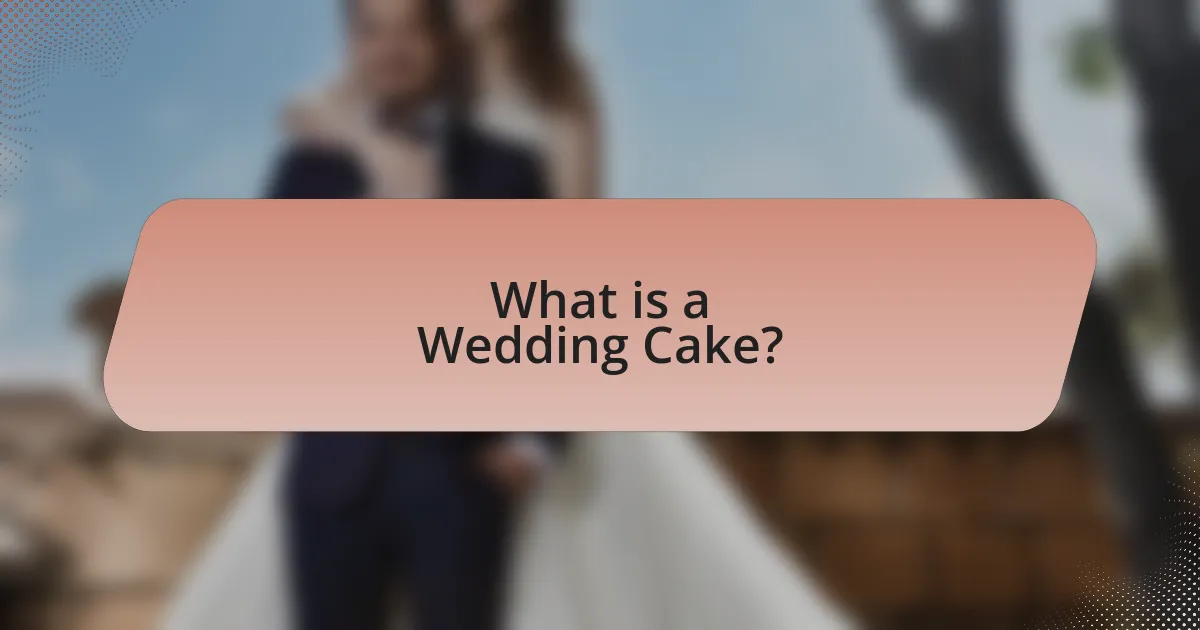
What is a Wedding Cake?
A wedding cake is a multi-tiered cake traditionally served at wedding receptions. It symbolizes prosperity and good fortune for the couple and is often elaborately decorated to reflect the wedding’s theme. Historically, wedding cakes date back to ancient Rome, where a wheat or barley cake was broken over the bride’s head to bestow fertility. In modern times, wedding cakes are typically made from rich ingredients like butter, sugar, and eggs, and can be flavored with various fillings and frostings.
How is a wedding cake different from other cakes?
A wedding cake is different from other cakes primarily due to its design, size, and significance in ceremonies. Wedding cakes are typically multi-tiered and elaborately decorated to symbolize the couple’s union, often featuring intricate designs, fondant, or sugar flowers, which are less common in standard cakes. Additionally, wedding cakes are often larger to serve a greater number of guests, reflecting the importance of the occasion. Historically, the tradition of wedding cakes dates back to ancient Rome, where cakes were made of wheat or barley and broken over the bride’s head for good fortune, establishing a cultural significance that distinguishes them from everyday cakes.
What are the traditional elements of a wedding cake?
The traditional elements of a wedding cake include multiple tiers, a rich fruitcake or sponge cake base, and decorative elements such as icing, fondant, and sugar flowers. Typically, wedding cakes are designed with three or more layers to symbolize the couple’s union, and they are often adorned with white icing to represent purity. Historically, the use of fruitcake dates back to ancient Rome, where it was believed to bring fertility and prosperity. The cake is usually topped with a cake topper, often depicting the couple, which adds a personal touch to the celebration.
Why is the wedding cake significant in wedding ceremonies?
The wedding cake is significant in wedding ceremonies because it symbolizes prosperity, fertility, and good fortune for the couple. Traditionally, the act of cutting the cake together represents the couple’s first joint task as partners, reinforcing their unity. Additionally, the sharing of the cake with guests signifies the couple’s desire to share their happiness and blessings with family and friends. Historically, the custom of wedding cakes dates back to ancient Rome, where a wheat or barley cake was broken over the bride’s head to bestow good fortune. This historical context underscores the cake’s enduring role in celebrating marital union and community.
What are the common types of wedding cakes?
The common types of wedding cakes include traditional fruit cakes, buttercream cakes, fondant cakes, and naked cakes. Traditional fruit cakes are dense and often soaked in alcohol, making them a classic choice for weddings. Buttercream cakes feature a soft, creamy frosting and can be easily customized in flavor and design. Fondant cakes are covered in a smooth layer of fondant, allowing for intricate decorations and a polished appearance. Naked cakes, which have little to no frosting on the sides, showcase the layers and fillings, providing a rustic look. Each type serves different aesthetic and taste preferences, catering to various wedding themes and styles.
What are the popular flavors for wedding cakes?
The popular flavors for wedding cakes include vanilla, chocolate, red velvet, lemon, and almond. Vanilla is favored for its classic taste and versatility, while chocolate is often chosen for its rich flavor. Red velvet offers a unique color and mild cocoa taste, making it a trendy option. Lemon provides a refreshing citrus flavor, and almond adds a distinct nutty essence. These flavors are commonly selected due to their appeal and compatibility with various fillings and frostings, making them suitable for a wide range of wedding themes and preferences.
How do different styles of wedding cakes reflect personal tastes?
Different styles of wedding cakes reflect personal tastes by showcasing individual preferences in design, flavor, and cultural significance. For instance, a classic tiered cake may indicate a preference for traditional elegance, while a minimalist cake can reflect a modern aesthetic. Additionally, flavors such as chocolate or red velvet can reveal personal favorites, and the incorporation of cultural elements, like a fruitcake in British weddings, highlights heritage and family traditions. These choices collectively illustrate how couples express their identities and values through their wedding cake selections.
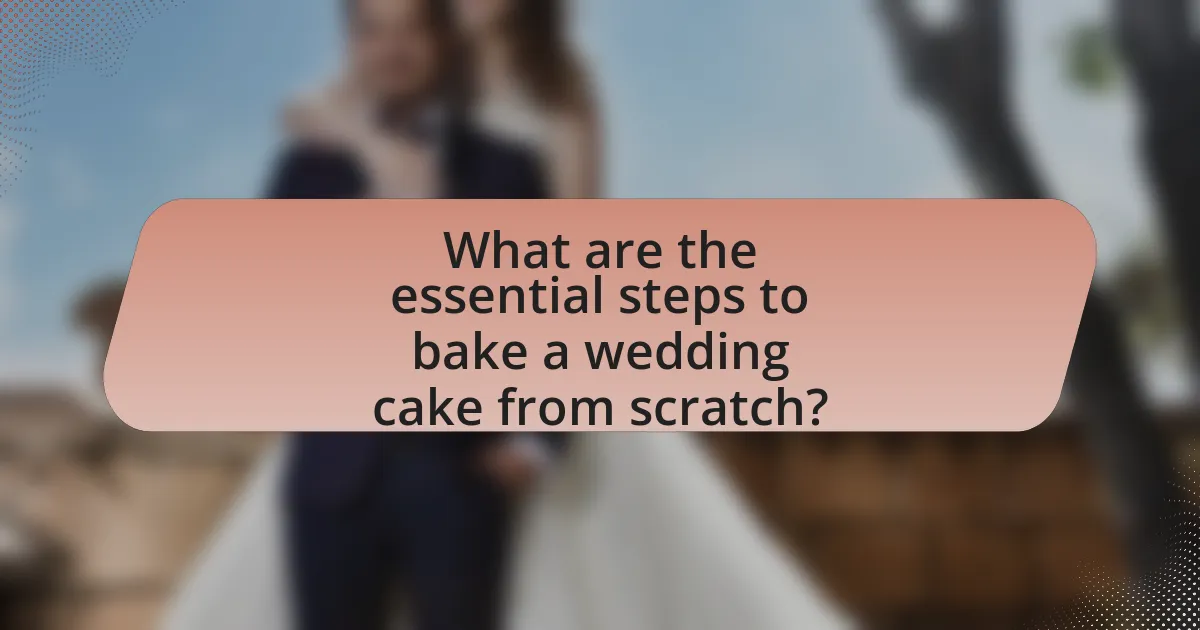
What are the essential steps to bake a wedding cake from scratch?
To bake a wedding cake from scratch, follow these essential steps: first, gather all necessary ingredients, including flour, sugar, eggs, butter, baking powder, and flavorings. Next, preheat the oven to the appropriate temperature, usually around 350°F (175°C). Then, prepare the cake pans by greasing and lining them with parchment paper.
After that, mix the dry ingredients in one bowl and the wet ingredients in another, combining them gradually to form a smooth batter. Pour the batter into the prepared pans and bake for the recommended time, typically 25-35 minutes, until a toothpick inserted in the center comes out clean.
Once baked, allow the cakes to cool completely before removing them from the pans. Finally, level the cakes, stack them with frosting in between, and decorate as desired. These steps ensure a well-structured and delicious wedding cake.
What ingredients do you need to bake a wedding cake?
To bake a wedding cake, you need flour, sugar, eggs, butter, baking powder, milk, and vanilla extract. These ingredients form the base of the cake batter, which is essential for creating a light and fluffy texture. Flour provides structure, sugar adds sweetness, eggs contribute moisture and richness, butter enhances flavor, baking powder acts as a leavening agent, milk adds moisture, and vanilla extract imparts a pleasant aroma.
How do the ingredients affect the cake’s texture and flavor?
The ingredients significantly influence a cake’s texture and flavor. For instance, flour provides structure; the type of flour used, such as all-purpose or cake flour, determines the cake’s density and crumb. Sugar not only sweetens but also contributes to moisture retention and tenderness, while fats like butter or oil create a rich flavor and a soft texture by coating flour proteins and preventing gluten formation. Eggs add moisture, richness, and stability, while also aiding in leavening, which affects the cake’s rise and lightness. Additionally, leavening agents like baking powder or baking soda produce carbon dioxide, causing the cake to rise and creating a light, airy texture. Flavorings such as vanilla or cocoa powder enhance the overall taste profile, making the cake more enjoyable. Each ingredient plays a crucial role in achieving the desired balance of texture and flavor in a wedding cake.
What are the best practices for measuring ingredients accurately?
The best practices for measuring ingredients accurately include using a digital kitchen scale for weight measurements, utilizing dry measuring cups for solid ingredients, and liquid measuring cups for liquids. A digital kitchen scale provides precise measurements in grams or ounces, which is crucial for baking, as even slight variations can affect the final product. For dry ingredients, filling the measuring cup without packing it down and leveling it off with a straight edge ensures accuracy. When measuring liquids, using a clear liquid measuring cup allows for easy reading at eye level, ensuring the correct volume. These methods are supported by baking science, which emphasizes the importance of accurate measurements for achieving consistent results in recipes.
How do you prepare the cake batter?
To prepare the cake batter, first, cream together softened butter and sugar until light and fluffy. This process incorporates air into the mixture, which helps the cake rise. Next, add eggs one at a time, ensuring each is fully incorporated before adding the next. Then, mix in vanilla extract for flavor. In a separate bowl, combine flour, baking powder, and salt, then gradually add this dry mixture to the wet ingredients, alternating with milk. This method prevents the batter from becoming too thick and ensures even mixing. Finally, mix until just combined, avoiding overmixing to maintain a tender cake texture.
What techniques ensure a light and fluffy cake batter?
To ensure a light and fluffy cake batter, techniques such as creaming butter and sugar, incorporating air through egg whites, and using the right flour type are essential. Creaming butter and sugar together until light and fluffy introduces air into the mixture, which helps the cake rise. Beating egg whites separately until stiff peaks form and then folding them into the batter adds additional volume and lightness. Additionally, using cake flour instead of all-purpose flour results in a finer crumb and a lighter texture due to its lower protein content. These methods are widely recognized in baking practices and are supported by culinary experts for achieving optimal cake texture.
How do you incorporate flavors into the batter?
To incorporate flavors into the batter, add extracts, zests, or spices directly into the wet ingredients before mixing with dry ingredients. For example, vanilla extract enhances sweetness, while citrus zests like lemon or orange provide a fresh, vibrant taste. Spices such as cinnamon or nutmeg can add warmth and depth. The incorporation of these flavorings at the beginning ensures even distribution throughout the batter, resulting in a well-flavored cake.
What are the baking and cooling processes for a wedding cake?
The baking process for a wedding cake involves preparing the batter, pouring it into cake pans, and baking it in a preheated oven at the specified temperature, typically around 325°F to 350°F, for a duration of 25 to 35 minutes, depending on the cake size and recipe. After baking, the cakes must be removed from the oven and allowed to cool in the pans for about 10 to 15 minutes before transferring them to a wire rack to cool completely, which usually takes an additional 1 to 2 hours. This cooling process is crucial as it prevents the cake from becoming soggy and ensures it maintains its structure for decorating.
How do you determine the right baking time and temperature?
To determine the right baking time and temperature, first consult the recipe, which typically specifies both. Baking temperature generally ranges from 325°F to 375°F, depending on the cake type, with most wedding cakes baking at 350°F. The baking time varies based on the cake size and pan type; for example, a standard 9-inch round cake usually takes 25 to 35 minutes. To ensure accuracy, use a toothpick or cake tester inserted into the center; if it comes out clean or with a few crumbs, the cake is done. This method is supported by baking science, which indicates that proper temperature and timing are crucial for achieving the desired texture and doneness in cakes.
What are the best methods for cooling the cake layers?
The best methods for cooling cake layers include using a wire rack, allowing the layers to cool in their pans for a short period, and then transferring them to the rack. This method promotes even cooling and prevents moisture buildup. Cooling on a wire rack allows air to circulate around the cake, which helps maintain its texture and prevents sogginess. Additionally, placing the cake layers in the refrigerator for a brief period after they have cooled to room temperature can further stabilize them before frosting. This technique is widely recommended by professional bakers for optimal results.
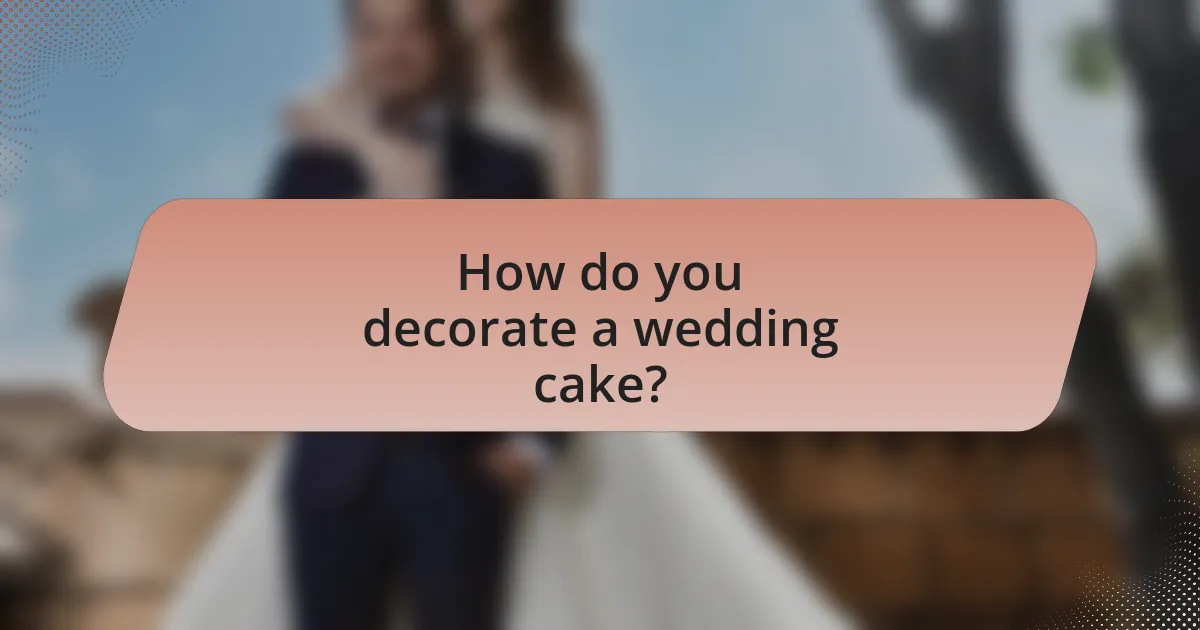
How do you decorate a wedding cake?
To decorate a wedding cake, start by applying a smooth layer of buttercream or fondant to create a clean base. This initial layer serves as the foundation for further decorations. Next, use piping techniques to add intricate designs, such as rosettes or lace patterns, which enhance the visual appeal. Additionally, fresh flowers or edible decorations can be strategically placed to complement the cake’s theme. According to cake decorating experts, a well-decorated wedding cake not only reflects the couple’s style but also adheres to the principles of balance and proportion, ensuring an aesthetically pleasing presentation.
What are the popular frosting options for wedding cakes?
The popular frosting options for wedding cakes include buttercream, cream cheese frosting, fondant, ganache, and whipped cream. Buttercream is favored for its versatility and ease of use, allowing for various flavors and decorations. Cream cheese frosting offers a tangy flavor that pairs well with many cake types, particularly carrot and red velvet. Fondant provides a smooth, polished finish and is often used for intricate designs. Ganache, made from chocolate and cream, adds a rich flavor and can be poured or whipped for different textures. Whipped cream is light and airy, suitable for a more casual presentation. These options are widely chosen for their taste, texture, and aesthetic appeal in wedding cakes.
How do you achieve a smooth finish with frosting?
To achieve a smooth finish with frosting, apply a thin layer of frosting known as a crumb coat first, then chill the cake to set it. This initial layer traps crumbs and provides a base for the final layer. After chilling, use a spatula or a bench scraper to apply a thicker layer of frosting, smoothing it out evenly. The use of a heated spatula can further enhance the smoothness by melting the frosting slightly as you spread it. This technique is supported by professional bakers who emphasize the importance of temperature control and tool choice for optimal results.
What techniques can be used for intricate cake decorations?
Intricate cake decorations can be achieved using techniques such as fondant covering, piping, airbrushing, and sugar crafting. Fondant covering allows for a smooth, polished finish that can be molded into various shapes and designs. Piping involves using a piping bag to create detailed designs with royal icing or buttercream, enabling intricate patterns and textures. Airbrushing adds depth and color gradients, enhancing the visual appeal of the cake. Sugar crafting involves creating decorative elements from sugar, such as flowers and figurines, which can be highly detailed and realistic. These techniques are widely used by professional bakers and cake decorators to create visually stunning cakes for events like weddings.
How can you personalize a wedding cake design?
To personalize a wedding cake design, couples can incorporate elements that reflect their unique relationship, such as favorite colors, meaningful symbols, or personal themes. For instance, using specific color palettes that match the wedding decor or including monograms can enhance the cake’s significance. Additionally, flavors that hold sentimental value, like a favorite dessert from a shared experience, can further customize the cake. According to a survey by The Knot, 70% of couples choose cake designs that reflect their personalities, demonstrating the importance of personalization in wedding cakes.
What are some creative ideas for cake toppers?
Creative ideas for cake toppers include personalized figurines, fresh flowers, and themed decorations. Personalized figurines can represent the couple or significant moments in their relationship, adding a unique touch. Fresh flowers, such as roses or peonies, provide a natural and elegant look, while themed decorations, like miniature wedding items or seasonal elements, can reflect the couple’s interests or wedding theme. These options enhance the visual appeal of the cake and can be tailored to fit various styles and preferences.
How do you incorporate wedding colors and themes into the cake design?
Incorporating wedding colors and themes into cake design involves selecting color palettes and decorative elements that reflect the overall wedding aesthetic. Bakers can achieve this by using colored fondant, buttercream, or edible paints that match the wedding’s color scheme. For example, if the wedding theme includes blush pink and gold, the cake can be covered in blush pink fondant with gold accents, such as edible gold leaf or gold-painted details. Additionally, incorporating themed decorations like floral arrangements or cake toppers that align with the wedding’s motif enhances the visual coherence of the cake with the event. This approach ensures that the cake not only serves as a dessert but also as a centerpiece that complements the wedding’s overall design.
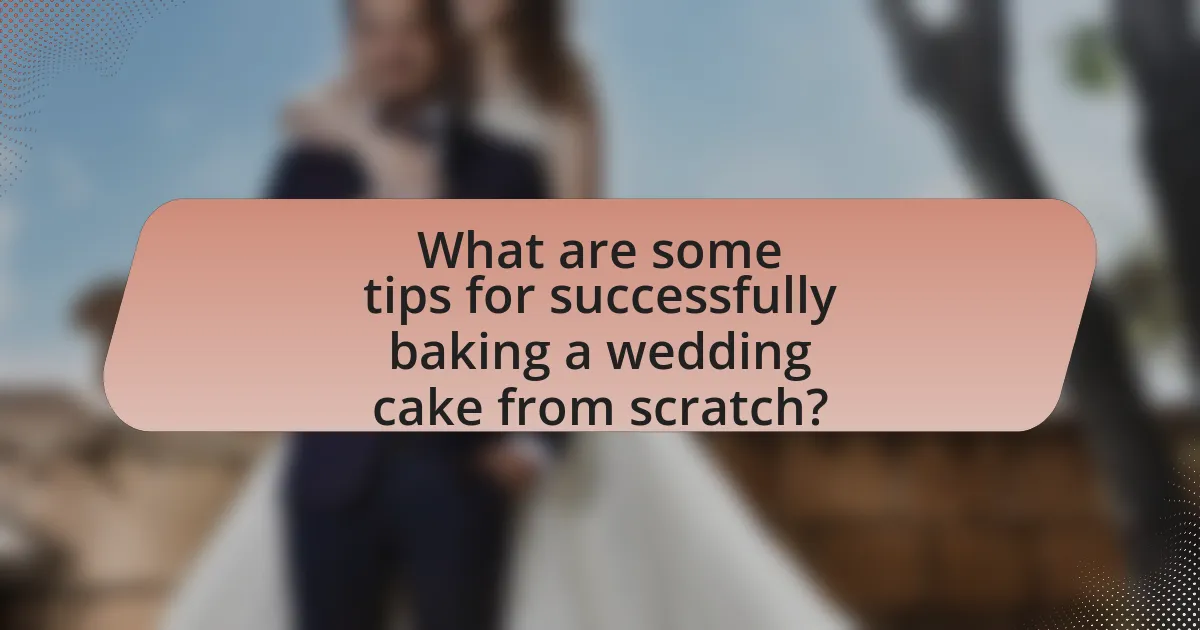
What are some tips for successfully baking a wedding cake from scratch?
To successfully bake a wedding cake from scratch, start by using high-quality ingredients, including fresh eggs, real butter, and pure vanilla extract, as these significantly impact flavor and texture. Measure ingredients accurately, as precision is crucial in baking; for example, using a kitchen scale can ensure consistency. Additionally, prepare your pans properly by greasing and lining them with parchment paper to prevent sticking.
Mix the batter gently to avoid overworking the gluten, which can lead to a dense cake. Bake at the correct temperature, typically around 350°F (175°C), and use an oven thermometer to verify accuracy, as uneven temperatures can affect the cake’s rise. Allow the cakes to cool completely before frosting to prevent melting and sliding.
Finally, consider practicing with smaller test cakes to refine your technique and adjust flavors before the final bake, ensuring the wedding cake meets expectations.
What common mistakes should you avoid when baking a wedding cake?
When baking a wedding cake, common mistakes to avoid include not properly measuring ingredients, which can lead to imbalanced flavors and textures. Accurate measurements are crucial, as even slight deviations can affect the cake’s rise and moisture. Another mistake is underbaking or overbaking the cake; using a reliable oven thermometer ensures the correct temperature, preventing dry or gooey results. Additionally, neglecting to level the cake layers can result in an uneven final product, so using a serrated knife to trim tops is essential. Lastly, failing to allow the cake to cool completely before frosting can cause the icing to melt, compromising the cake’s appearance and structure.
How can you troubleshoot baking issues effectively?
To troubleshoot baking issues effectively, first identify the specific problem, such as uneven baking, texture issues, or flavor discrepancies. For example, if a cake is unevenly baked, check the oven temperature with an oven thermometer, as inaccurate temperatures can lead to poor results. Additionally, ensure that ingredients are measured accurately; using too much flour can result in a dense cake. According to the American Test Kitchen, precise measurements and proper oven calibration are crucial for successful baking outcomes. By systematically addressing each issue and verifying the baking environment and ingredient quality, bakers can resolve problems and improve their results.
What are the best practices for storing and transporting a wedding cake?
The best practices for storing and transporting a wedding cake include keeping it in a cool, dry place and using a sturdy cake box for transport. Storing the cake in a refrigerator helps maintain its freshness, especially if it contains perishable ingredients like cream or fruit. When transporting, ensure the cake is securely placed in a box that prevents movement and protects it from external elements. Additionally, avoid stacking items on top of the cake during transport to prevent damage. These practices are essential to preserve the cake’s structure and appearance, ensuring it arrives at the venue in optimal condition.
